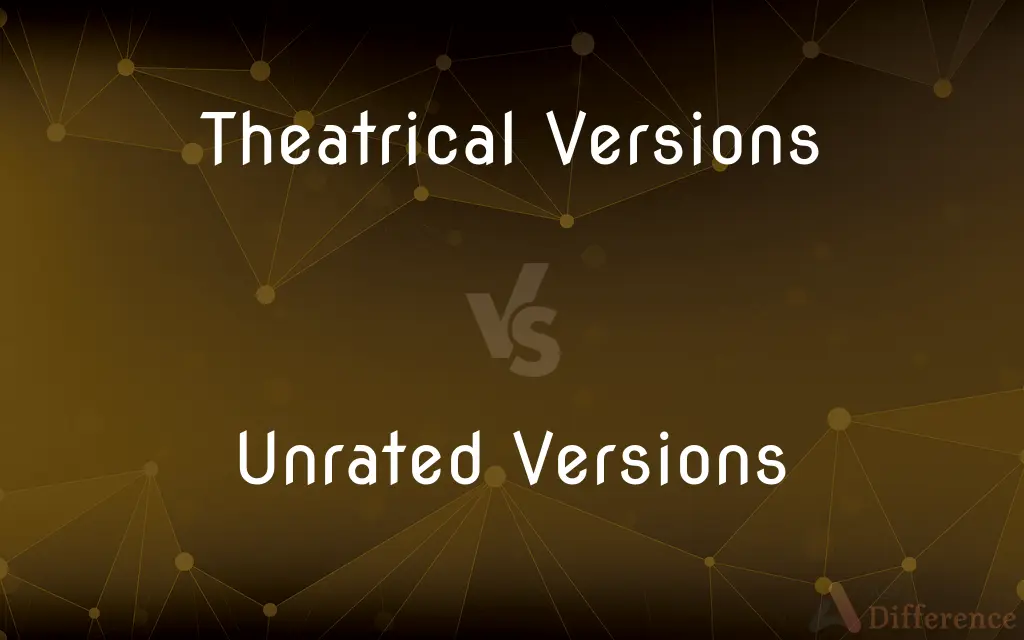Theatrical Versions vs. Unrated Versions — What's the Difference?
By Tayyaba Rehman — Published on January 30, 2024
Theatrical versions of movies are edited for wider audience appeal and adhere to rating guidelines, while unrated versions contain additional content not shown in theaters, often with no official rating.

Difference Between Theatrical Versions and Unrated Versions
Table of Contents
ADVERTISEMENT
Key Differences
Theatrical versions are the cuts of movies released in cinemas, edited to meet certain runtime constraints and content guidelines set by film rating boards. Unrated versions, often released for home viewing, contain additional material that was not included in the theatrical release, typically due to rating or time restrictions.
Theatrical versions usually adhere to the requirements of rating agencies, such as the MPAA in the United States, to obtain a specific rating that determines the audience suitability. Unrated versions, however, may include extended scenes, alternative endings, or content that could alter the film's initial rating, and are not submitted for official rating.
Content-wise, theatrical versions are often more conservative, with edits made to avoid higher age ratings that could limit the audience. Unrated versions can have more explicit scenes, whether in terms of violence, language, or bad content, offering a potentially different viewing experience.
The choice between watching a theatrical or unrated version often depends on viewer preference. Those seeking the version intended for broad audiences might opt for the theatrical cut, while viewers interested in a potentially fuller or more explicit version of the story may choose the unrated edition.
The marketing of unrated versions often highlights the additional content, enticing viewers with the promise of seeing more than what was shown in theaters. This strategy can increase home media sales, as it offers something new even for those who have already seen the theatrical version.
ADVERTISEMENT
Comparison Chart
Content Guidelines
Adhere to rating agency guidelines
May contain content altering initial rating
Audience
Broader audience appeal
Viewers seeking more explicit content
Edits
Conservative, adhering to runtime limits
Extended scenes, alternative endings
Release Format
In cinemas
Home viewing formats
Marketing Appeal
Wide audience reach
Additional content not seen in theaters
Compare with Definitions
Theatrical Versions
Edited for cinema release.
The theatrical version was shorter than the director's cut.
Unrated Versions
Marketed for its additional material.
Fans were excited about the extra footage in the unrated version.
Theatrical Versions
Meets film rating guidelines.
The theatrical version received a PG-13 rating.
Unrated Versions
Contains additional content.
The unrated version included deleted scenes.
Theatrical Versions
Aimed at a wider audience.
The theatrical version avoided explicit content for broader appeal.
Unrated Versions
Often released for home viewing.
The unrated version was a special feature on the DVD.
Theatrical Versions
Released in theaters.
I saw the theatrical version on its opening night.
Unrated Versions
May have explicit scenes.
The unrated version revealed more graphic content.
Theatrical Versions
Often has a shorter runtime.
Some scenes were cut in the theatrical version to meet time constraints.
Unrated Versions
Not officially rated.
The unrated version was more explicit, hence not submitted for rating.
Common Curiosities
Are theatrical versions shorter than unrated versions?
Typically, yes, due to edits for runtime and content.
What is a theatrical version of a movie?
It's the version released in cinemas, edited for wider audience appeal.
Why would a movie have an unrated version?
To include additional or more explicit content that was cut from the theatrical release.
Do unrated versions get released in theaters?
Usually, they are released for home viewing.
What does 'unrated version' mean?
It includes content not shown in theaters, often without an official rating.
Can the unrated version change the story of the film?
It can offer more depth or alternative perspectives to the story.
Is the unrated version the same as a director's cut?
Not always; a director's cut is the director’s own preferred edit, which may or may not be unrated.
Why are theatrical versions edited?
For content suitability, runtime, and to meet rating guidelines.
Are unrated versions more explicit?
They often include scenes that are more explicit in nature.
Do all films have an unrated version?
Not all; it depends on the director's choice and studio policies.
How do ratings affect the theatrical version of a movie?
They determine what content is appropriate for certain audiences.
Why would viewers choose to watch an unrated version?
For more comprehensive content or to see parts omitted from the theatrical release.
Are unrated versions more popular for certain genres?
They are often more common in genres like horror, thriller, and adult comedy.
Can watching an unrated version lead to a different understanding of the film?
Yes, additional content can offer new insights or alter the viewing experience.
Who decides what goes into an unrated version?
Typically, the film's director and/or studio.
Share Your Discovery

Previous Comparison
Ionic Compound vs. Molecular Compound
Next Comparison
AKA vs. DeltaAuthor Spotlight
Written by
Tayyaba RehmanTayyaba Rehman is a distinguished writer, currently serving as a primary contributor to askdifference.com. As a researcher in semantics and etymology, Tayyaba's passion for the complexity of languages and their distinctions has found a perfect home on the platform. Tayyaba delves into the intricacies of language, distinguishing between commonly confused words and phrases, thereby providing clarity for readers worldwide.














































